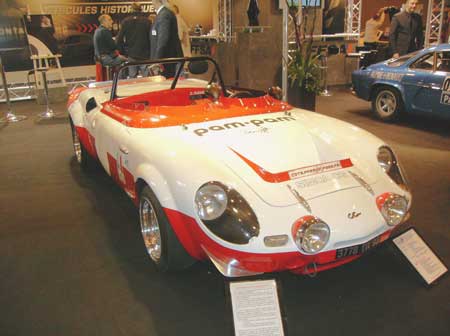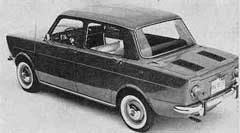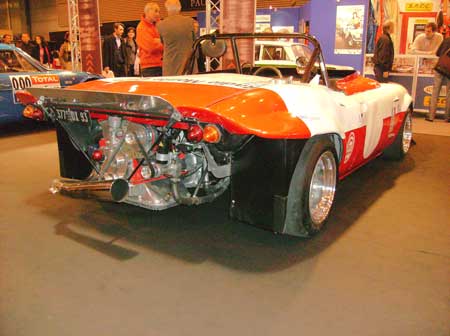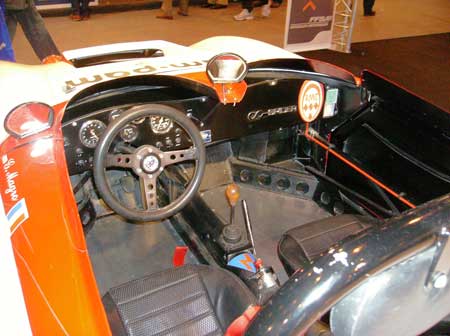Story and photos by Brandy Elitch

The CG was made in both coupe and spyder configurations, but this spyder was recently spotted at the Retro show.
The CG was a derivative of the Simca 1000 sedan, a very successful small four-door sedan manufactured from 1961-1978, with 2 million cars sold.
A new motor was designed just for the 1000 (known as “Mille†in France): an in-line, water-cooled, 4-cylinder with 5 main bearings and a crossflow head. It had a 35/65 weight distribution, and, later on, 4 wheel discs and a fully articulated rear suspension. Styling was in the econobox mode, although rumored to have been done by Mario Boano.

The Simca 1000 was a very popular
car produced from 1961 to 1978.
SIMCA (La Societe Industrielle de Mechanique et de Carrosserie Automobile) – the French love acronyms – started making FIAT’s under license, but by 1954 were successful enough to buy Ford of France. However, when the Suez crisis hit in 1956, they didn’t have a small car in the showrooms. Subsequently, in 1958 they got some financial assistance from Chrysler USA, which bought a part of the company, and the rest in 1963 – kind of a reverse of the situation at Chrysler later on.
The initials of the CG stand for the founders, the Chappe brothers and de Gessalin, who set up a workshop in 1957. Previously, they had worked for Delahaye and built custom bodies. Later they gravitated to fiberglass bodies for Alpine, CD, and DB. They decided that they wanted to build their own car, so worked out an alliance with Simca, and in 1966 unveiled the first model at the Paris show, the Spyder 1000, with a welded steel frame with a central girder. However, it was underpowered, so the following year it was replaced by a new model, the Sport 1000, with a removable hardtop. The logo was the French cockerel, drawn by the artist Uderzo, who is famous for his Asterix comic strip; the idea came from the factory’s address: Rue de Coq Gaulois, in Brie Comte Robert. Ultimately, the factory produced a total of about 405 cars (30 A1000, 280 B1200, and 95 C1300).

Like the contemporary Abath Simca, the GG packed a sting in the tail. This version boats a 1730cc engine and supercharger.
The car shown in the picture, exhibited at Retromobile in February, 2008, was a 1970 548 spyder, one of 5 made. It has a 1730 cc motor, assisted by a Constantin supercharger, and weights only 550 kilograms. The car chalked up 32 rally victories between 1970 and 1973, driven by Daniel Ruggeri, Paul Bernard, and Gerard Magro. It is rumored that some of the performance guys at Chrysler France had a hand in producing the car. Ultimately, the Matra Simca Bagheera became the favorite child and displaced the CG at Simca, which by then was known as the “anti-Alpine.â€

This car is reported to have won 32 rally victories.
Fortunately, the CG has had collector car status since it was new, so most cars survived, and are carefully cared for today.
Hello
fortunately there is a concise book (in French only):
Chappe Gesselin–Les artisans constructeurs
From (my good pal) Michel Delannoy.
More on http://www.editions-palmier.fr
This publisher/bookdealer is absolutely worth a visit (cyber-wise)and if you happen to be in South France (Nimes), personally.
Best regards Michael
Wow, fantastic! Thank you for covering this not very known aspect of French cars. Having been raised there, I knew mostly of the A310 but this CG has my heart.
Some other cars that would be fun to cover are the Matra V12 series. I know the guy who restored the first 630. I thought Italian V12 were top in their lines until I heard this French contender.
Thanks for a very insightful article.
Nick
CG-MC Today
I read with pleasure your June 18th, 2008 article « The original anti-Alpine » concerning the C.G. brand and the interest for American readers for small French brands (Alpine, Matra, René Bonnet, D.B., etc…)
At the 1966 Paris Auto Show, Chappe & Gessalin presented for the first time their CG 1000 convertible. Seasoned onlookers and competition praised the quality of the product with the beautiful chassis main central beam with steel platform and lateral compartments. Unfortunately, the small rear-end 50hp, 1.0 liter engine from the SIMCA 1000GLS was disappointing.
Quickly, enthusiasts improved this car and entered some small rallies with noticeable results.
Starting 1970, drivers’ pressures had a lighter and improved version more competition orientated, the type 548. Engine capacity was increased to 1.2 liter with the adjunction of a volumetric compressor and now developing 120 hp
But the type 548 couldn’t be homologated as a GT due to the small quantity produced, and it had to compete against real prototypes.
In 1969, the SIMCA society had developed a competition department, which managed a rich priced and very successful « Challenge Simca » for the products and lasted several years, including the Simca powered CG.
From 1966 to 1974, total production was 405 cars, among them 25 type 548. Seven or eight of that model were open spider, identical to the one in your article.
Challenge Simca main drivers were Philippe Renaudat, Cossuta, Ruggieri and Gorse.
The CHRYSLER group, willing to compete against FORD and GM in Europe in that segment, entered the capital of ROOTES in the UK and of SIMCA in France.
They hired two men who already had succeeded in establishing the FORD success in Europe and more specifically their Mustang product (creation of a competition department with good drivers, the FORD LOTUS SEVEN challenge and also show-biz with Claude Lelouch’s film « Un homme et une femme », 1st prize at the 1966 Cannes Festival.)
This winning team, Ford-France CEO American William Reiber, plus PR and competition manager Frenchman Henri Chemin, did everything they could to put together a winning and successful operational team.
William Reiber had a good relationship and a real friendship with Jean-Luc Lagardère, the founder and CEO of MATRA, through whom he supplied FORD-COSWORTH engines for the F3, F2 and F1 Matras of the TYRELL team organization.
They signed a commercial agreement and MATRA- ELF became MATRA- SIMCA -SHELL.
According to that agreement, it was decided that the MATRA study department with engineers Bernard Boyer (chassis) and Georges Martin (engine), would study “project MS 18†and realize a real prototype for the Rally championship.
Five CG-MC protos were built at CG, with 220hp twin ignition, dry-sump Chrysler-France central engines, Porsche transmission, and Matra type 630 suspensions. Total weight was less than 700 kg./1.500 lbs.
These formidable machines won 32 victories between 1970 and 1973 with factory drivers Bernard Fiorentino, Gérard Larrousse, Michel Saliba and Philippe Renaudat (1972 Challenge Simca winner).
This CG-MC period and its development was a « nightmare » for ALPINE and PORSCHE.
( I could tell you a lot more if you wish…)
William Reiber’s early death (cancer), plus the 1973 oil crisis, stopped the nice CG adventure.
It also speeded-up the scheduled death of the SIMCA brand with its selling to the PSA group (PEUGEOT) a few years latter.
I can suggest the excellent book « Chappe et Gessalin, les artisans constructeurs » written by Michel Delannoy, éditions du Palmier, http://www.editions-palmier.fr
Francis.
I found this item in Veloce by searching for “Matra Bagheera”. This lovely CG Spyder of Gerard Magro still holds the Hill Climb Record of the Etretat to Benouville event in late August in Nomandy France. I also compete in that event in my Matra Simca Bagheera usually finishing close to the bottom of the results sheet! The CG uses the same base engine as the 1442cc Bagheera and has had the Constantin Supercharger added. Matra themselves experimented with manufacture of a GRP supercharger and details are in the excellent Bagheera “Bible” by Andre Dewael including a comparison with the performance of the contemporary Porsche 924. Before I found the Dewael book I had also fitted a Wade twin rotor Supercharger to my competition Bagheera which now produces a very similar output to the Matra design. Scruitineers at Etretat used to complain that my car was “pas Historique” but I am now able to show that Matra themselves produced a prototype Supercharged 1442cc version of their engine which bears a remarkable resemblance to mine! (Strictly I suppose that mine bears a resemblance to theirs since theirs came first!) Gerard Magro kindly sent me a photograph of my Bagheera on the Etretat start line through the steering wheel of his CG Spyder – the car in this article. A nice “circular” story.